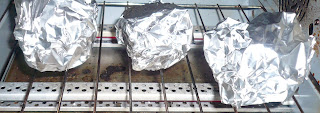When I received a call from a friend informing me that she was "downsizing" her backyard, I was there with shovel in hand. Her yard is beautiful with a large variety of perennials.
Fall is a good time to dig up and separate perennials, 30 to 45 days before the first frost. You can also separate the perennials in the spring before it gets hot.
Divide the plants a day or two after it rains, or water well beforehand. Try to pick a cool, overcast day to help keep the plants from drying out. Dig around the plant to "lift" the root ball or "slice" out sections with a shovel. (I would like to say this part is pretty, but it is not.) We filled up bags and boxes adding dirt to help protect the roots.
I filled the car up and drove the two hours back home. Once home, I watered everything to keep the plants from drying out overnight.
Ideally, you should replant asap in prepared planting areas. (If unable, keep the roots covered with dirt and water to create mud. Keep the mixture wet until you are ready to plant.) Replant to the same depth as the original. Water well.
Mulch the first winter to prevent heaving.
 |
| Day One....dig. dig. dig..... |
 |
| Trunk |
 |
| Back seat |
 |
| The bounty! |
 |
| Day Two, plant, plant plant.... |
 |
| The end of day two! |






















